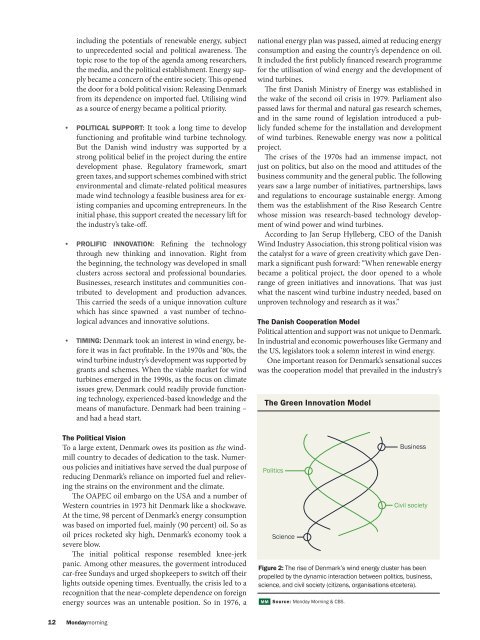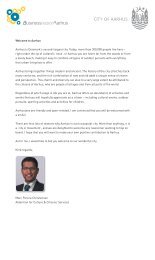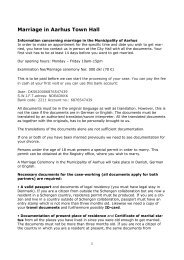Aarhus – Capital of Wind Energy - Aarhus.dk
Aarhus – Capital of Wind Energy - Aarhus.dk
Aarhus – Capital of Wind Energy - Aarhus.dk
- No tags were found...
Create successful ePaper yourself
Turn your PDF publications into a flip-book with our unique Google optimized e-Paper software.
including the potentials <strong>of</strong> renewable energy, subjectto unprecedented social and political awareness. Thetopic rose to the top <strong>of</strong> the agenda among researchers,the media, and the political establishment. <strong>Energy</strong> supplybecame a concern <strong>of</strong> the entire society. This openedthe door for a bold political vision: Releasing Denmarkfrom its dependence on imported fuel. Utilising windas a source <strong>of</strong> energy became a political priority.• POLITICAL SUPPORT: It took a long time to developfunctioning and pr<strong>of</strong>itable wind turbine technology.But the Danish wind industry was supported by astrong political belief in the project during the entiredevelopment phase. Regulatory framework, smartgreen taxes, and support schemes combined with strictenvironmental and climate-related political measuresmade wind technology a feasible business area for existingcompanies and upcoming entrepreneurs. In theinitial phase, this support created the necessary lift forthe industry’s take-<strong>of</strong>f.• PROLIFIC INNOVATION: Refining the technologythrough new thinking and innovation. Right fromthe beginning, the technology was developed in smallclusters across sectoral and pr<strong>of</strong>essional boundaries.Businesses, research institutes and communities contributedto development and production advances.This carried the seeds <strong>of</strong> a unique innovation culturewhich has since spawned a vast number <strong>of</strong> technologicaladvances and innovative solutions.• TIMING: Denmark took an interest in wind energy, beforeit was in fact pr<strong>of</strong>itable. In the 1970s and ‘80s, thewind turbine industry’s development was supported bygrants and schemes. When the viable market for windturbines emerged in the 1990s, as the focus on climateissues grew, Denmark could readily provide functioningtechnology, experienced-based knowledge and themeans <strong>of</strong> manufacture. Denmark had been training <strong>–</strong>and had a head start.The Political VisionTo a large extent, Denmark owes its position as the windmillcountry to decades <strong>of</strong> dedication to the task. Numerouspolicies and initiatives have served the dual purpose <strong>of</strong>reducing Denmark’s reliance on imported fuel and relievingthe strains on the environment and the climate.The OAPEC oil embargo on the USA and a number <strong>of</strong>Western countries in 1973 hit Denmark like a shockwave.At the time, 98 percent <strong>of</strong> Denmark’s energy consumptionwas based on imported fuel, mainly (90 percent) oil. So asoil prices rocketed sky high, Denmark’s economy took asevere blow.The initial political response resembled knee-jerkpanic. Among other measures, the goverment introducedcar-free Sundays and urged shopkeepers to switch <strong>of</strong>f theirlights outside opening times. Eventually, the crisis led to arecognition that the near-complete dependence on foreignenergy sources was an untenable position. So in 1976, anational energy plan was passed, aimed at reducing energyconsumption and easing the country’s dependence on oil.It included the first publicly financed research programmefor the utilisation <strong>of</strong> wind energy and the development <strong>of</strong>wind turbines.The first Danish Ministry <strong>of</strong> <strong>Energy</strong> was established inthe wake <strong>of</strong> the second oil crisis in 1979. Parliament alsopassed laws for thermal and natural gas research schemes,and in the same round <strong>of</strong> legislation introduced a publiclyfunded scheme for the installation and development<strong>of</strong> wind turbines. Renewable energy was now a politicalproject.The crises <strong>of</strong> the 1970s had an immense impact, notjust on politics, but also on the mood and attitudes <strong>of</strong> thebusiness community and the general public. The followingyears saw a large number <strong>of</strong> initiatives, partnerships, lawsand regulations to encourage sustainable energy. Amongthem was the establishment <strong>of</strong> the Risø Research Centrewhose mission was research-based technology development<strong>of</strong> wind power and wind turbines.According to Jan Serup Hylleberg, CEO <strong>of</strong> the Danish<strong>Wind</strong> Industry Association, this strong political vision wasthe catalyst for a wave <strong>of</strong> green creativity which gave Denmarka significant push forward: “When renewable energybecame a political project, the door opened to a wholerange <strong>of</strong> green initiatives and innovations. That was justwhat the nascent wind turbine industry needed, based onunproven technology and research as it was.”The Danish Cooperation ModelPolitical attention and support was not unique to Denmark.In industrial and economic powerhouses like Germany andthe US, legislators took a solemn interest in wind energy.One important reason for Denmark’s sensational succeswas the cooperation model that prevailed in the industry’sThe Green Innovation ModelPoliticsScienceBusinessCivil societyFigure 2: The rise <strong>of</strong> Denmark’s wind energy cluster has beenpropelled by the dynamic interaction between politics, business,science, and civil society (citizens, organisations etcetera).A Fresh BreezeBehind every product is a creative mind. Two creative mindsare behind INA/FAG bearings <strong>–</strong> a team that is twice as strong:Schaeffler Group Industrial.Renowned for creative technology and for 30 years <strong>of</strong> experiencein the wind turbine industry, we know what customersreally want. Continued close collaboration with manufacturersand operators provides impetus for both sides. New findingsfrom practical experiences are immediately implemented inour calculation and CAE tools that we use to initially generatevirtual models <strong>of</strong> our products. In reality they then becomehigh-performance gearbox bearings or durable main rotorbearings. Alternatively they are integrated in WiPro, our onlinemonitoring system, which is GL and AZT certified and used allover the world.A fresh breeze is blowing in the world <strong>of</strong> bearings technology.Make sure you benefit from it too!The Schaeffler Group with its brands INA, FAG and LuK, and currently around 65,000 employees at more than 180 locations ranks amongst the leading rollingSource: Monday Morning & CBS.bearing manufacturers and suppliers to the automotive industry worldwide. The group <strong>of</strong> companies stands for global customer proximity, innovative ability andthe highest possible level <strong>of</strong> quality. In Denmark, Schaeffler Group is represented by Schaeffler Danmark ApS with head <strong>of</strong>fice in <strong>Aarhus</strong> and sales <strong>of</strong> the INA andFAG brands to more than 60 different industrial sectors.12 Mondaymorning <strong>Aarhus</strong> <strong>–</strong> <strong>Capital</strong> <strong>of</strong> <strong>Wind</strong> <strong>Energy</strong> 13www.schaeffler.<strong>dk</strong>




